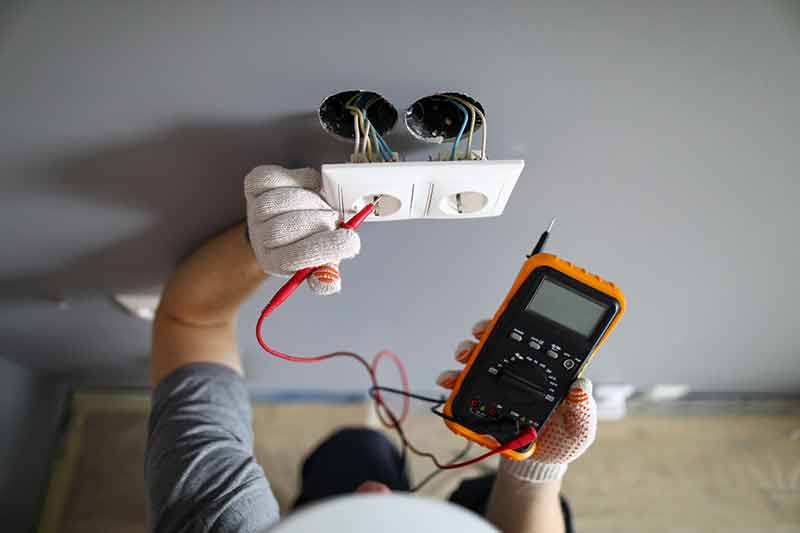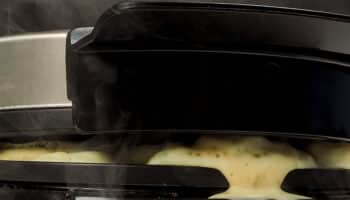Is your ice cream machine not working?
You’re not alone! Having issues with your ice cream maker can be super annoying, especially during summer.
But don’t worry; I’m here to help.
If your ice cream maker is not working, you’re probably underfilling or overfilling it. A bad outlet, damaged power cord, jammed paddle, blown fuse, or rust can also explain the problem.
Read on to learn how to fix ice cream machines!
Ice Cream Machine Troubleshooting
In this section, I’ll guide you through the most common reasons that can explain why you’re having ice cream maker issues and provide various solutions.
We’ll start by addressing quick solutions for a malfunctioning ice cream maker. However, if it is a recurring problem, it’s best to skip ahead to #4 and beyond for more in-depth troubleshooting.
#1 You’re Not Adding Enough Ice Cream Mix
When troubleshooting an ice cream machine, I always check the amount of ice cream mix.
You see, ice cream makers are specifically engineered to freeze a certain amount of ice cream mix properly. Putting too much or too little can cause your machine to malfunction.
Not adding enough ice cream mix to your recipes can cause them to turn out frozen, full of ice, and probably hard to eat. If the mix becomes frozen solid, your paddle will have a lot of trouble moving, which could make it look like it’s failing.
A little salt can help soften the mix, but it’s best to get it right from the start without adding additional ingredients.
So, if the mix is too hard, but everything else seems to work normally within your appliance, a quantity error could be to blame. Prepare another batch, and give it another go!
#2 You’re Overfilling Your Base
If your ice cream maker is still not working, ensure you’re not overfilling the base.
While underfilling your machine will make the mixture too hard, overfilling it can lead to a consistency that’s excessively soft and watery.
Overfilling the base can strain the motor and overheat it, as the ice cream machine will have to run longer to get you the desired results.

Do not exceed the maximum capacity of your ice cream maker. You should aim to fill it to about 2/3 of its total capacity, allowing enough room for the ice cream to expand during the freezing process.
If your appliance overheated and burned your motor, you’re better off calling a professional. However, if you absolutely must do the repairs yourself, you’ll need to disassemble your ice cream maker and remove the motor. Then, do a quick Google search to find the right replacement that will fit your make and model and proceed to reassemble.
#3 The Paddle Is Jammed
The next step in the ice cream maker troubleshooting process is to check the paddle.
Your ice cream maker’s paddle will save you a lot of trouble, but several user-related errors can cause it to jam, leading to different performance issues.
Is the ice cream maker paddle not turning? Then carefully unplug the ice cream maker and remove the paddle. Clean all the residue stuck to it and add a little more salt to your ice cream mixture.
Salt will melt the ice through a chemical reaction with water and make it a little more manageable.

If cleaning the paddle and adding salt to the mixture didn’t solve the issue, the motor is likely the issue. In such cases, you’re better off calling a specialized technician to repair it.
#4 Your Components Are Rusty
I tend to find that when an ice cream maker malfunctions, it’s typically because of rust.
Unfortunately, even the moisture inside your kitchen can contribute to rust and the appearance of mold.
Rust in the paddle or motor of an ice cream machine can make it difficult for the components to move freely and compromise their adequate operation.
It’s crucial to be very diligent when cleaning your ice cream maker’s components and let them dry completely before putting them back in place to prevent the formation of mold and rust and guarantee hygienic conditions during operation and serving.
If you’re still at a stage where preventive measures can save your ice cream machine from further damage, following the instructions above can work wonders for you. On the other hand, if there is already a significant amount of rust in your components, it’s time to replace them.
#5 You Have a Bad Outlet
If you’ve tried the fixes above, but your ice cream maker is still not working, there is a good chance that the problem lies not in the component but in your wall outlet or power cord.

A faulty power outlet can be the symptom of multiple issues, ranging from something negligible as a loose wire behind it, to more concerning situations, like a general malfunction in your home’s electrical layout.
Whatever the case, there’s one thing for sure. Your ice cream maker is not working, and a bad outlet could be why.
Carefully unplug your ice cream machine, and take it to a different section of your house. Preferably, as far away as possible from the outlet you normally use. Then, plug it back into a different outlet and see if the issue is resolved. If it is, great! If it isn’t, don’t worry. There’s still a lot of ground to cover.
Additionally, if you’re up for a challenge, you can test your outlet with a multimeter. As I said before, a faulty outlet could be the symptom of a larger electrical failure that can give you trouble later on. Best to nip it in the bud.
#6 Your Power Cord Is Damaged
If you’re still struggling with a malfunctioning ice cream maker, it’s time to check the power cord.
Most cords look sturdy and thick, so you’d think they would be very resilient, but they’re not. In fact, small bad practices, like storing them improperly, pressing them against a wall, or keeping them tangled, are more than enough to cause many problems.
The severity of the damage will also determine what the symptoms are.
For example, if the cord is completely broken, your ice cream maker won’t turn on, but if it’s only partially damaged, it could cause a short circuit and kill your appliance. In such cases, you should avoid using the ice cream maker and replace the cable.
I know you probably don’t have a spare cable lying around, but on the off chance that you do, you can use it to try and power your appliance, as long as it meets the damaged one’s amperage and voltage specifications.
If you’re like most of us and don’t have a spare cable lying around just waiting to be tested, don’t worry. Finding a new one should be fairly simple.
All you have to do is run a quick Google search on your ice cream machine’s make and model, and you should be able to find a replacement for less than $20 at any online marketplace.
#7 There’s a Blown Fuse
The last step in the ice cream machine troubleshooting process is to inspect the fuses.
In case you’re unfamiliar with what fuses do, they’re responsible for “blowing” to cut off all electric continuity inside your ice cream maker when they sense extreme heat or power surges from blackouts.
A blown fuse is extremely likely to be the culprit if your ice cream maker stopped working right after a blackout or an extended period of operation.

Please unplug your ice cream maker and read the manufacturer’s manual to locate the fuse compartment. Then, inspect the fuse and look for any signs of a small explosion, like blackening or a broken filament inside the glass body.
Once you have determined the fuse is, in fact, blown, you can find a replacement easily at your nearest hardware store.
If the issue persists, I would advise looking at your warranty status. If you’re still under coverage, you should try contacting the manufacturer and see if you can get it repaired for free. If not, you’ll probably need to buy a new model.
Wrapping Up: How to Keep Your Ice Cream Maker Running Smoothly
Hopefully, now you know how to fix your ice cream machine issues.
Remember that if your ice cream maker is not working, you’ll need to use the right amount of ingredients and clean the paddle and other components. Don’t forget to inspect the outlet, power cord, and fuses. Replace any component if necessary.
Thank you so much for reading. Please check out our other related posts below if you found this article helpful.
Enjoy your treat!









